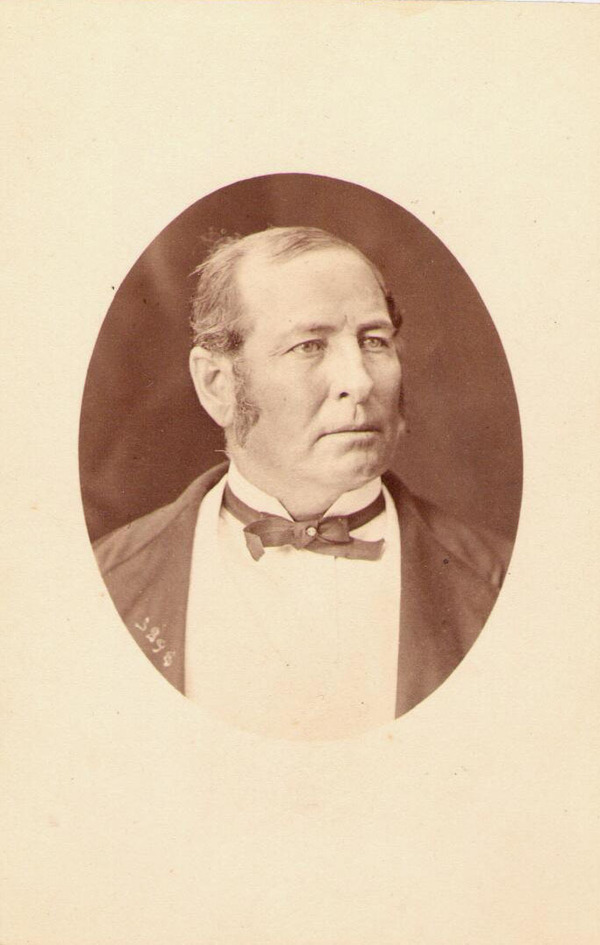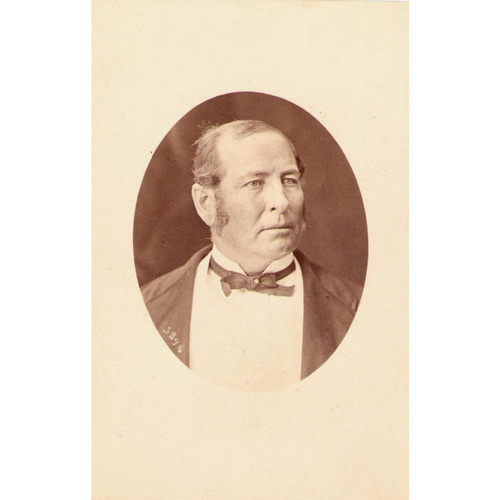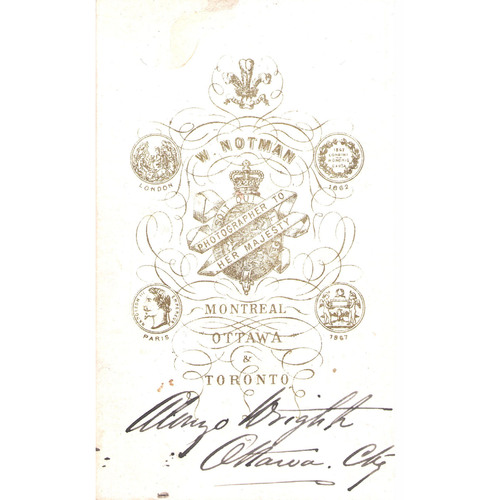
Source: Link
WRIGHT, ALONZO, lumberman, farmer, militia officer, and politician; b. 28 April 1821 in Hull, Lower Canada, eldest son of Tiberius Wright and Lois Ricker, and grandson of Philemon Wright*; m. 1 April 1848 Mary Sparks, daughter of Nicholas Sparks*; they had no children; d. 7 Jan. 1894 in Ironside, Que.
Following the deaths of Alonzo Wright’s grandfather Philemon Wright in 1839, of his father Tiberius in 1841, and of his uncle Christopher Columbus in 1843, the Wright family business came into the hands of Philemon’s only surviving son, Ruggles. The process of dividing a large portion of the patriarch’s estate equally between Ruggles and Tiberius engendered endless conflict. The heirs of Tiberius, who did not trust Ruggles, accused him of embezzlement and launched numerous lawsuits against him. It was Alonzo Wright who took charge of this offensive against his uncle.
Alonzo became a lumberman in 1846. At that time William Farmer, who had been leasing the Gatineau Falls Farm since 29 Sept. 1834, decided to give up the property, along with its mills, timber slides, dams, and timber limits, all of which then reverted to the family of Tiberius. Alonzo thus found himself obliged to administer the property. Not much is known about this period of his life, except that he was engaged in lumbering and that he worked in the forest even after his marriage to Mary Sparks, as two letters sent to her during the winter of 1851 show. Although some said his wife had brought him a “substantial” dowry, he had to remain in an occupation he did not much like. His father-in-law, who had been employed by Philemon Wright, had made his fortune by purchasing what was later to become the centre of Bytown (Ottawa). He had married Sarah Olmstead Wright, the widow of Alonzo’s uncle Philemon. There were, then, close ties between Alonzo and his in-laws, who were his uncle and aunt by marriage.
Not until later could Wright adopt the style of life he liked best – that of “gentleman farmer.” His income would then enable him to devote himself to raising sheep, cattle, and pure-bred horses, to the activities of the Ottawa County Agricultural Society (of which he later became president) and the Ottawa Agricultural Society (of which he became a director), to his duties as lieutenant-colonel in the Ottawa County non-service militia, to politics, and above all to his reading. In this rugged “Ottawa valley country,” he became, in the eyes of his contemporaries, a “seigneur,” whose residence and princely style of life confirmed him as “King of the Gatineau.” His “subjects” in Ottawa County and his friends in politics knew him by this title. A number of letters written to Wright by Sir John A. Macdonald begin: “My dear king.”
Wright’s political career spanned the years from 1863 to 1891. He was first elected to the Legislative Assembly of the Province of Canada for Ottawa riding and held the seat from 30 June 1863 to 1 July 1867. After confederation he represented it in the House of Commons from 1867 to 1891, being re-elected in 1872, 1874, 1878, 1882, and 1887, as a Liberal-Conservative. Although Wright’s name is closely associated with that of Macdonald and with the fortunes of the Conservative party, he did not become one of their supporters until about 1863. In his youth he had in fact been an admirer of the Reformers Robert Baldwin* and Louis-Hippolyte La Fontaine*.
Wright was never flamboyant as a member of parliament. He seldom spoke in the house, but when he did he attracted attention, with his grasp of the subject, remarkable sense of humour, and notable eloquence. He understood well the needs of the Ottawa region and acted as its champion. He fought hard for the development of agriculture and the encouragement of colonization, and he supported the improvement of transportation through the building of canals on the Ottawa River and of railways such as the Quebec, Montreal, Ottawa and Occidental.
On 21 March 1870 Wright introduced a bill “respecting the marking of timber.” This bill was applauded by all the leading lumbermen in the Ottawa valley, including Ezra Butler Eddy*, George Bryson, John Maclaren, and John Mather*, because it would establish the ownership of sawlogs. Shortly before leaving politics, Wright launched an attack in the house on D’Alton McCarthy and the adherents of the Equal Rights Association, for, among other things, seeking to abolish the system of Catholic and Protestant public schools in Manitoba. As an educated man, Wright respected French culture and championed the cause of equality for the two founding peoples. For him, the greatness of Canada depended on respect for the typically British virtues of fair play, justice, and truth. Wright had always detested fanaticism and cliques. In an earlier period he had come to the defence of the Ottawa valley Irvingites, a group inspired by the Reverend Adam Hood Burwell*. These disciples of Edward Irving, who preached the imminent second coming of Christ, were in fact persecuted for their beliefs. Wright, who was a liberal in matters of religion, assailed the people of Hull for harassing the sect.
Alonzo Wright’s great open-mindedness, his generosity, and his proverbial hospitality made him one of the most respected politicians of his generation. He was honoured by his colleagues on both sides of the house in 1876, in 1877, in 1881, in April 1890, and on other occasions. Although a close friend of Macdonald, his leader, he maintained personal friendships with such figures as Wilfrid Laurier*, Peter Mitchell, Edward Blake*, and Honoré Mercier. That so many leading citizens accompanied his body to its final resting-place is the clearest sign of the esteem in which he was held. Flags in the Hull-Ottawa region were flown at half-mast the day of his funeral.
ANQ-0, CN1–7, nos.786, 1006, 1144–45, 1152, 1174, 1248, 1748, 1985, 2632, 2970, 3173, 3178, 3187, 3192, 3230, 3298, 3302–6, 3536, 3538, 3578. BE, Hull, reg. B, 5: 16–17, no.4084; 8: 858–62, no.7888. NA, MG 24, D8; MG 26, A; MG 27,1, D5: 8–10;178; MG 30, D1, 31. Que., Parl., Doc. de la session, 1872, no.4: 140–41. Ottawa Citizen, 22 Sept. 1871; 11, 22–23 Jan., 3, 22 April, 21 May, 14 June, 5, 11, 18 July, 4 Oct., 6 Dec. 1872; 4 July, 3, 8–9 Oct. 1873; 7, 9, 14, 22–23 Jan., 2, 4, 7 Feb., 20 April 1874; 14 Sept., 22 Oct., 11 Dec. 1875; 17 Feb., 4 April 1876; 18 Jan., 21, 26 March, 9 April, 15, 30 June, 14 Aug. 1877; 8–10 Jan. 1894. Ottawa Evening Journal, 23 April 1890; 8, 10 Jan. 1894. Canadian directory of parl. (Johnson). CPC, 1880. Encyclopædia of religion and religions, comp. E. R. Pike (New York, [1958]). Statistiques électorales fédérales du Québec, 1867–1980, Pierre Drouilly, compil. (Montréal, 1983). S. D. Clark, Church and sect in Canada (Toronto, 1948), 307–12. J. L. Gourlay, History of the Ottawa valley: a collection of facts, events and reminiscences for over half a century (Ottawa, 1896), 169, 186–87, 214–19. Registered timber marks of eastern Canada from 1870 to 1984, comp. Diane Alfred ([Ottawa], 1985). Léo Rossignol, “Histoire documentaire de Hull, 1792–1900” (thèse de phd, univ. d’Ottawa, 1941), 119–20. Henri Lestage, Restauration du salon Alonzo Wright (Touraine, Qué., 1980). L.-P. Turcotte, Le Canada sous l’Union, 1841–1867 (2v., Québec, 1871–72), 2: 424, 454, 477, 494, 511, 552. Maurice Gobeil, “Le ‘Roi de la Gatineau’ et le Collège Saint-Alexandre,” L’Enseignement secondaire au Canada (Québec), 40 (1961–62). Up the Gatineau! (Chelsea, Que.), no.4 (1978); no.6 (1980).
Cite This Article
Pierre-Louis Lapointe, “WRIGHT, ALONZO,” in Dictionary of Canadian Biography, vol. 12, University of Toronto/Université Laval, 2003–, accessed November 6, 2024, https://www.biographi.ca/en/bio/wright_alonzo_12E.html.
The citation above shows the format for footnotes and endnotes according to the Chicago manual of style (16th edition). Information to be used in other citation formats:
| Permalink: | https://www.biographi.ca/en/bio/wright_alonzo_12E.html |
| Author of Article: | Pierre-Louis Lapointe |
| Title of Article: | WRIGHT, ALONZO |
| Publication Name: | Dictionary of Canadian Biography, vol. 12 |
| Publisher: | University of Toronto/Université Laval |
| Year of publication: | 1990 |
| Year of revision: | 1990 |
| Access Date: | November 6, 2024 |




